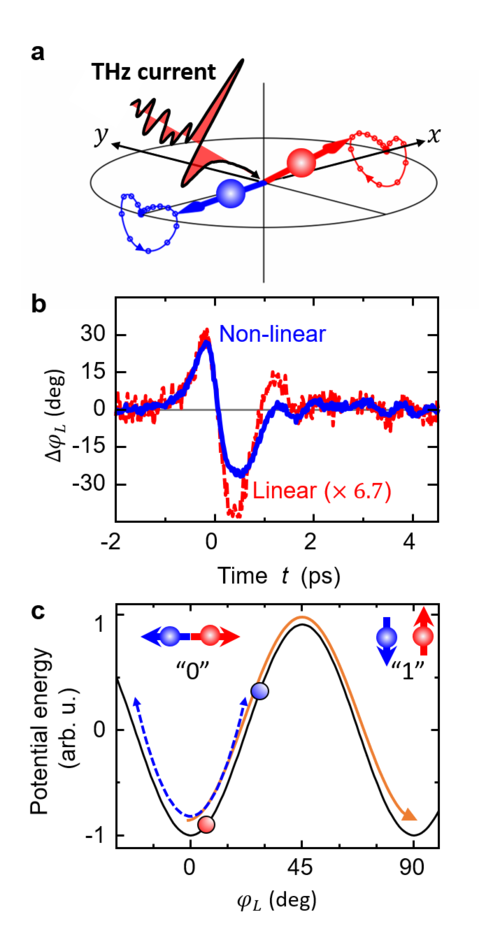Terahertz currents launch massive spin rotation in an antiferromagnet
News from Sep 28, 2023
Researchers of the TRR227 at FU Berlin with collaborators in Mainz and Dresden find that spin dynamics in an antiferromagnetic metal can be excited by terahertz electric rather than magnetic fields. Enhanced by exchange-interaction, the spins are deflected by as much as 30° out of their equilibrium direction. By demonstrating this highly nonlinear response, spin rotation by 90° and, thus, ultrafast writing of an antiferromagnetic bit by terahertz electric currents comes into close reach.
In ferromagnets, the spins of the electrons are ordered parallel, resulting in a macroscopic magnetic moment. In contrast, antiferromagnets such as Mn2Au contain a second set of parallel spins that compensates the magnetic moment of the first one perfectly (Fig. 1a). Despite the absence of magnetization, antiferromagnets can store information by aligning spins along the axis (bit is 0, Fig. 1a) or the perpendicular axis (bit is 1). Compared to ferromagnets, antiferromagnets have attractive properties for data storage: They are robust against external magnetic fields and long-time stable, yet may switch very fast, when an appropriate stimulus is provided. In the developing field of antiferromagnetic spintronics, one core goal is the writing of information by electric currents, which is possible in novel metallic antiferromagnets like Mn2Au.
“Given the increasing amounts of data in modern information technology, it is important to control antiferromagnetic order as fast as possible.”, says Yannic Behovits from Freie Universität Berlin. In the study published in Nature Communications [1], Behovits and colleagues show that spins in Mn2Au can be deflected by a short electric-current pulse that is driven by an intense terahertz (THz) electric field. The spin deflection is monitored by a highly sensitive femtosecond laser pulse. Following the initial deflection of the spins, the researchers find a coherent spin oscillation with a frequency of 0.6 THz.
“The electric field alone actually only leads to small canting of neighboring spins by less than 1°. However, the resulting exchange fields between antiparallel spins are strong and quickly drive the spins away from their equilibrium orientation,” Yannic Behovits explains. And this exchange-enhanced oscillation is no longer a small perturbation: For the most intense excitation, the spins deflect by as much as 30° (Fig. 1b).
These results not only provide insights into fundamental magnetic properties of Mn2Au, but also open a path towards ultrafast switching, as Alexander Chekhov points out: “If the THz electric current can be further enhanced, the spins overcome the barrier at 45° (Fig. 1c) and should rotate into the next stable orientation at 90°. And it would only take them around one picosecond to get there.”
Figure 1:
a) Sketch of the evolution of initially antiparallel spins (red and blue arrows) in antiferromagnetic Mn2Au after excitation by a terahertz electric-current pulse (black-red waveform).
b) Pump-induced spin deflection angle of each spin vs pump-probe delay . Small terahertz electric currents lead to linear spin dynamics (red line), while large current amplitudes drive non-linear dynamics (blue line). The linear signal has been scaled up to highlight the waveform changes occurring in the non-linear regime.
c) Schematic potential energy of a spin vs. its in-plane deflection angle . Stable minima are at 0°(Bit “0”) and 90° (Bit “1”). Red and blue dot indicate the maximum amplitude reached for the two waveforms in (b). Blue dotted-line indicates the reversible spin dynamics observed in panel (b). The orange line indicates a possible switching event, changing the antiferromagnetic bit state from “0” to “1”.
Original publication:
Y. Behovits, A. L. Chekhov, S. Yu. Bodnar, O. Gueckstock, S. Reimers, Y. Lytvynenko, Y. Skourski, M. Wolf, T.S. Seifert, O. Gomonay, M. Kläui, M. Jourdan, T. Kampfrath. Terahertz Néel spin-orbit torques drive nonlinear magnon dynamics in
antiferromagnetic Mn2Au. Nat. Commun. 14, 6038 (2023).
